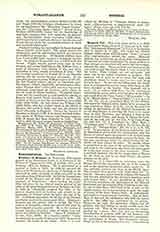

Humeral Veil. —This is the name given to a cloth of rectangular shape, about 81 ft. long and 11 ft. wide. The “Caeremoniale Romanum” (I. I, c. x, n. 5) requires that it should be of silk. The edges are usually fringed, while a cross, with the name “Jesus”, or some other representation adorns the center. Humeral veils for use on festivals are often richly embroidered. To prevent too rapid wearing out by usage, pockets or flaps (wings) are provided well under the lower edges, towards the ends. These are then used instead of the veil itself to hold the object which is to be covered by the latter. Flaps (wings) are not advisable; but there can be no serious objection to pockets. The humeral veil is worn so as to cover the back and shoulders—hence its name—and its two ends hang down in front. To prevent its falling from the shoulders, it is fastened across the breast with clasps or ribbons attached to the border. The humeral veil is used: (I) at solemn high Mass, by the subdeacon, who holds the paten with it from the close of the Offertory until after the Pater Noster (“Ritus celebr.”, vii, 9, in “Missale Rom.”; “Caerem. Episc.”, 1. I, c. x, n. 6; II, viii, 60); (2) at a pontifical Mass, by the acolyte, who bears the bishop’s mitre, unless he be wearing the cope (Caeremon. Episc., I, xi, 6); (3) by the priest or bishop in processions of the Blessed Sacrament, in giving Benediction, in carrying the Host to its repository on Holy Thursday, and bringing it back to the altar on Good Friday, and finally in taking the Viaticum to the sick (see rit. for Fer. V. in Coena Domini, and Fer. VI. in Parasceve, in “Miss. Rom.”; “Caeremon. episc.”, 1. II, c. xxiii, n. 11, 13; xxv, 31, 32; xxxiii, 27; “Rituale Rom.”, Tit. IV, c. iv, n. 9; IX, v, 3). In processions of the Blessed Sacrament, and at Benediction given with the ostensorium, only the hands are placed under the humeral veil; in other cases it covers the sacred vessel which contains the Host. In the cases mentioned under the third heading the humeral veil must always be white. No specific color is prescribed in the case of the mitre-bearer, but the veil worn by the subdeacon who bears the paten must be of the same color as the other vestments. There is no black humeral veil, for the reason that at Masses for the dead, as well as on Good Friday, the paten remains on the altar.
History.—It is impossible to determine when the Roman Ritual first prescribed the use of the humeral veil on the occasions mentioned above, under (3). It was probably towards the close of the Middle Ages. The custom is first alluded to in “Ordo Rom. XV” (c. lxxvii). In many places outside of Rome the humeral veil was not adopted for the aforesaid functions until very recent times. It was prescribed in Milan, by St. Charles Borromeo, for processions of the Blessed Sacrament and for carrying Holy Viaticum to the sick. Its use at high Mass dates back as far at least as the eighth century, for it was mentioned, under the name of sindon, in the oldest Roman Ordo. It undoubtedly goes back to a more remote antiquity. But, in those days, it was not the subdeacon who held the paten with it; this office was performed by an acolyte. Moreover, not only this particular acolyte, but all acolytes who had charge of sacred vessels wore the humeral veil. That of the paten-bearer was distinguished by a cross. One may find an interesting reproduction of acolytes with alb and humeral veil (sindon) in a ninth-century miniature of a sacramentary (reproduced in Braun, “Die liturgische Gewandung”, p. 62) in the seminary of Autun. Some time in the eleventh century the custom was inaugurated of having the paten borne, no longer by an acolyte, but by the subdeacon; this was especially the case at Rome. The subdeacon then had no humeral veil, but rather held the paten with the pall (mappula, palla, sudarium), the forerunner of our chalice veil, the ends of which were thrown over the right shoulder. Thus it is prescribed by “Ordo Rom. XIV” (c. liii), and so it may be seen in various reproductions. The acolyte continued, even in the later Middle Ages, to use a humeral veil (palliolum, sindon, mantellum) when carrying the paten, and the present Roman custom, according to which the subdeacon is vested in the humeral veil when holding the paten, originated at the close of the Middle Ages. It was slow in finding its way into use outside of Rome, and was not adopted in certain countries (France, Germany) until the nineteenth century. The veil used by the mitre-bearer is mentioned as far back as “Ordo Rom. XIV” (c. xlviii).
JOSEPH BRAUN

